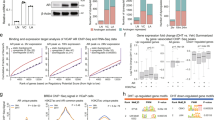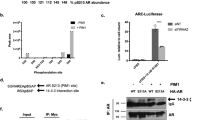Abstract
The androgen receptor (AR) is a ligand-dependent transcription factor that plays a crucial role in the development and homeostasis of the prostate and in prostate cancer. The transcriptional activity of AR is mediated by interaction with multiple co-activators, which serve in chromatin modification or remodeling, or provide a link between specific and general transcription factors. We have identified zipper interacting protein (ZIP) kinase as a novel transcriptional co-activator of the AR. ZIP kinase enhanced expression of AR-responsive promotor/luciferase reporter constructs in a hormone- and kinase-dependent manner. Similar results were obtained for glucocorticoid receptor but not for progesterone receptor and estrogen receptor. Following hormone treatment, AR and ZIP kinase formed physical complexes and associated with the promoter and enhancer of the prostate-specific antigen gene, as revealed by chromatin immunoprecipitation. Strikingly, depletion of ZIP kinase by siRNA led to significant reduction of AR-mediated transactivation. The interaction of ZIP kinase with AR seems to be mediated in part by apoptosis antagonizing transcription factor and in part by direct binding. Interestingly, AR was not phosphorylated by ZIP kinase in vitro, suggesting that it phosphorylates other co-activators or chromatin proteins.
This is a preview of subscription content, access via your institution
Access options
Subscribe to this journal
Receive 50 print issues and online access
$259.00 per year
only $5.18 per issue
Buy this article
- Purchase on Springer Link
- Instant access to full article PDF
Prices may be subject to local taxes which are calculated during checkout







Similar content being viewed by others
References
Bruno T, De Angelis R, De Nicola F, Barbato C, Di Padova M, Corbi N et al. (2002). Che-1 affects cell growth by interfering with the recruitment of HDAC1 by Rb. Cancer Cell 2: 387–399.
Bruno T, De Nicola F, Iezzi S, Lecis D, D'Angelo C, Di Padova M et al. (2006). Che-1 phosphorylation by ATM/ATR and Chk2 kinases activates p53 transcription and the G2/M checkpoint. Cancer Cell 10: 473–486.
Burgdorf S, Leister P, Scheidtmann KH . (2004). TSG101 interacts with apoptosis-antagonizing transcription factor and enhances androgen receptor-mediated transcription by promoting its monoubiquitination. J Biol Chem 279: 17524–17534.
Chen S, Xu Y, Yuan X, Bubley GJ, Balk SP . (2006). Androgen receptor phosphorylation and stabilization in prostate cancer by cyclin-dependent kinase 1. Proc Natl Acad Sci USA 103: 15969–15974.
Debes JD, Tindall DJ . (2002). The role of androgens and the androgen receptor in prostate cancer. Cancer Lett 187: 1–7.
Di Padova M, Bruno T, De Nicola F, Iezzi S, D'Angelo C, Gallo R et al. (2003). Che-1 arrests human colon carcinoma cell proliferation by displacing HDAC1 from the p21WAF1/CIP1 promoter. J Biol Chem 278: 36496–36504.
Engemann H, Heinzel V, Page G, Preuss U, Scheidtmann KH . (2002). DAP-like kinase interacts with the rat homolog of Schizosaccharomyces pombe CDC5 protein, a factor involved in pre-mRNA splicing and required for G2/M phase transition. Nucleic Acids Res 30: 1408–1417.
Fanciulli M, Bruno T, Di Padova M, De Angelis R, Iezzi S, Iacobini C et al. (2000). Identification of a novel partner of RNA polymerase II subunit 11, Che- 1, which interacts with and affects the growth suppression function of Rb. FASEB J 14: 904–912.
Felten A, Leister P, Burgdorf S, Uhlmann L, Scheidtmann KH . (2007). Characterization of rat BLOS2/Ceap, a putative yeast She3 homolog, as interaction partner of apoptosis antagonizing transcription factor/Che-1. Biol Chem 388: 569–582.
Gao S, Wang H, Lee P, Melamed J, Li CX, Zhang F et al. (2006). Androgen receptor and prostate apoptosis response factor-4 target the c-FLIP gene to determine survival and apoptosis in the prostate gland. J Mol Endocrinol 36: 463–483.
Gioeli D, Ficarro SB, Kwiek JJ, Aaronson D, Hancock M, Catling AD et al. (2002). Androgen receptor phosphorylation. Regulation and identification of the phosphorylation sites. J Biol Chem 277: 29304–29314.
Haystead TA . (2005). ZIP kinase, a key regulator of myosin protein phosphatase 1. Cell Signal 17: 1313–1322.
Kawai T, Akira S, Reed JC . (2003). ZIP kinase triggers apoptosis from nuclear PML oncogenic domains. Mol Cell Biol 23: 6174–6186.
Kawai T, Matsumoto M, Takeda K, Sanjo H, Akira S . (1998). ZIP kinase, a novel serine/threonine kinase which mediates apoptosis. Mol Cell Biol 18: 1642–1651.
Kim J, Coetzee GA . (2004). Prostate specific antigen gene regulation by androgen receptor. J Cell Biochem 93: 233–241.
Kögel D, Bierbaum H, Preuss U, Scheidtmann KH . (1999). C-terminal truncation of Dlk/ZIP kinase leads to abrogation of nuclear transport and high apoptotic activity. Oncogene 18: 7212–7218.
Kögel D, Prehn JH, Scheidtmann KH . (2001). The DAP kinase family of pro-apoptotic proteins: novel players in the apoptotic game. BioEssays 23: 352–358.
Leister P, Burgdorf S, Scheidtmann KH . (2003). Apoptosis antagonizing transcription factor AATF is a novel co-activator of nuclear hormone receptors. Signal Transduction 3: 17–25.
Lohrum M, Scheidtmann KH . (1996). Differential effects of phosphorylation of rat p53 on transactivation of promoters derived from different p53 responsive genes. Oncogene 13: 2527–2539.
Lonard DM, O'malley BW . (2006). The expanding cosmos of nuclear receptor coactivators. Cell 125: 411–414.
McEwan IJ . (2004). Molecular mechanisms of androgen receptor-mediated gene regulation: structure–function analysis of the AF-1 domain. Endocr Relat Cancer 11: 281–293.
McKenna NJ, O'malley BW . (2002). Combinatorial control of gene expression by nuclear receptors and coregulators. Cell 108: 465–474.
Muller JM, Isele U, Metzger E, Rempel A, Moser M, Pscherer A et al. (2000). FHL2, a novel tissue-specific coactivator of the androgen receptor. EMBO J 19: 359–369.
Nelson JD, Denisenko O, Sova P, Bomsztyk K . (2006). Fast chromatin immunoprecipitation assay. Nucleic Acids Res 34: e2.
Otten AD, Sanders MM, McKnight GS . (1988). The MMTV LTR promoter is induced by progesterone and dihydrotestosterone but not by estrogen. Mol Endocrinol 2: 143–147.
Page G, Kögel D, Rangnekar V, Scheidtmann KH . (1999a). Interaction partners of Dlk/ZIP kinase: co-expression of Dlk/ZIP kinase and Par-4 results in cytoplasmic retention and apoptosis. Oncogene 18: 7265–7273.
Page G, Lödige I, Kögel D, Scheidtmann KH . (1999b). AATF, a novel transcription factor that interacts with Dlk/ZIP kinase and interferes with apoptosis. FEBS Lett 462: 187–191.
Rosenfeld MG, Glass CK . (2001). Coregulator codes of transcriptional regulation by nuclear receptors. J Biol Chem 276: 36865–36868.
Sato N, Kawai T, Sugiyama K, Muromoto R, Imoto S, Sekine Y et al. (2005). Physical and functional interactions between STAT3 and ZIP kinase. Int Immunol 17: 1543–1552.
Scheidtmann KH . (2007). Dlk/ZIP kinase, a novel Ser/Thr-specific protein kinase with multiple functions. Signal Transduction 7: 248–259.
Shang Y, Hu X, DiRenzo J, Lazar MA, Brown M . (2000). Cofactor dynamics and sufficiency in estrogen receptor-regulated transcription. Cell 103: 843–852.
Taplin ME, Balk SP . (2004). Androgen receptor: a key molecule in the progression of prostate cancer to hormone independence. J Cell Biochem 91: 483–490.
Thomas T, Voss AK, Petrou P, Gruss P . (2000). The murine gene, Traube, is essential for the growth of preimplantation embryos. Dev Biol 227: 324–342.
Ueda T, Bruchovsky N, Sadar MD . (2002). Activation of the androgen receptor N-terminal domain by interleukin-6 via MAPK and STAT3 signal transduction pathways. J Biol Chem 277: 7076–7085.
Wang Q, Carroll JS, Brown M . (2005). Spatial and temporal recruitment of androgen receptor and its coactivators involves chromosomal looping and polymerase tracking. Mol Cell 19: 631–642.
Wu RC, Smith CL, O'malley BW . (2005). Transcriptional regulation by steroid receptor coactivator phosphorylation. Endocr Rev 26: 393–399.
Acknowledgements
We thank Gerd Landsberg for excellent technical assistance. Dr Roland Schuele and Dr Ma Yin (University Hospital, Freiburg, Germany) for their hospitality and introduction to the ChIP technique and for the reporter plasmid PSA-enhancer-luc and expression plasmid for progesterone receptor; and Dr Maurizio Fanciulli (Regina Elena Cancer Institute, Rome, Italy) for antibodies against AATF/Che-1 and for providing the sequence for AATF/Che1-specific siRNA. This work was supported by the German Research Council Grant Sche246/16-1.
Author information
Authors and Affiliations
Corresponding author
Additional information
Supplementary Information accompanies the paper on the Oncogene website (http://www.nature.com/onc).
Supplementary information
Rights and permissions
About this article
Cite this article
Leister, P., Felten, A., Chasan, A. et al. ZIP kinase plays a crucial role in androgen receptor-mediated transcription. Oncogene 27, 3292–3300 (2008). https://doi.org/10.1038/sj.onc.1210995
Received:
Revised:
Accepted:
Published:
Issue Date:
DOI: https://doi.org/10.1038/sj.onc.1210995
Keywords
This article is cited by
-
A homologous mapping method for three-dimensional reconstruction of protein networks reveals disease-associated mutations
BMC Systems Biology (2018)
-
Zipper-interacting protein kinase is involved in regulation of ubiquitination of the androgen receptor, thereby contributing to dynamic transcription complex assembly
Oncogene (2013)
-
Apoptosis-antagonizing transcription factor (AATF) gene silencing: role in induction of apoptosis and down-regulation of estrogen receptor in breast cancer cells
Biotechnology Letters (2013)
-
Mutation analysis of the AATF gene in breast cancer families
BMC Cancer (2009)



